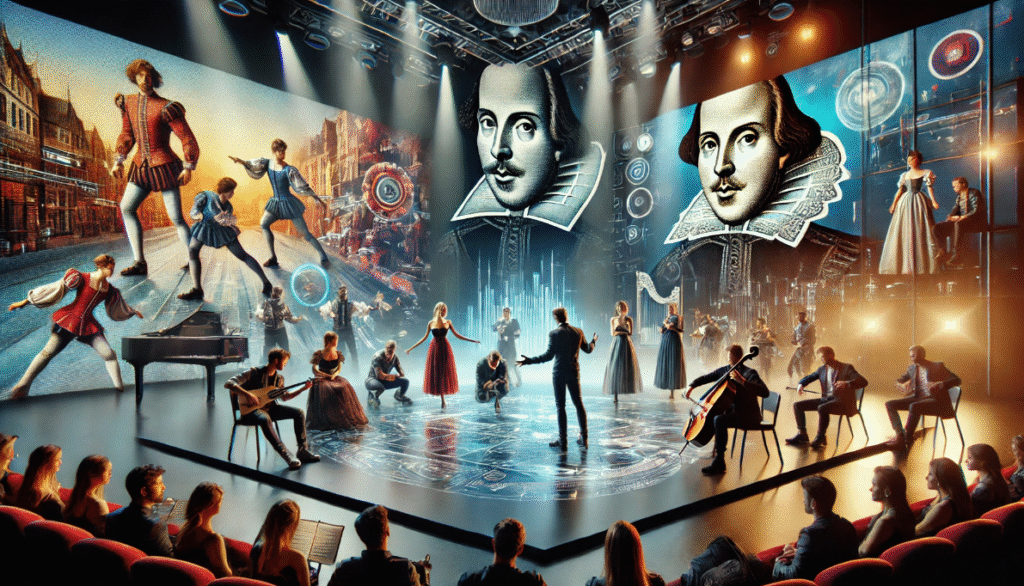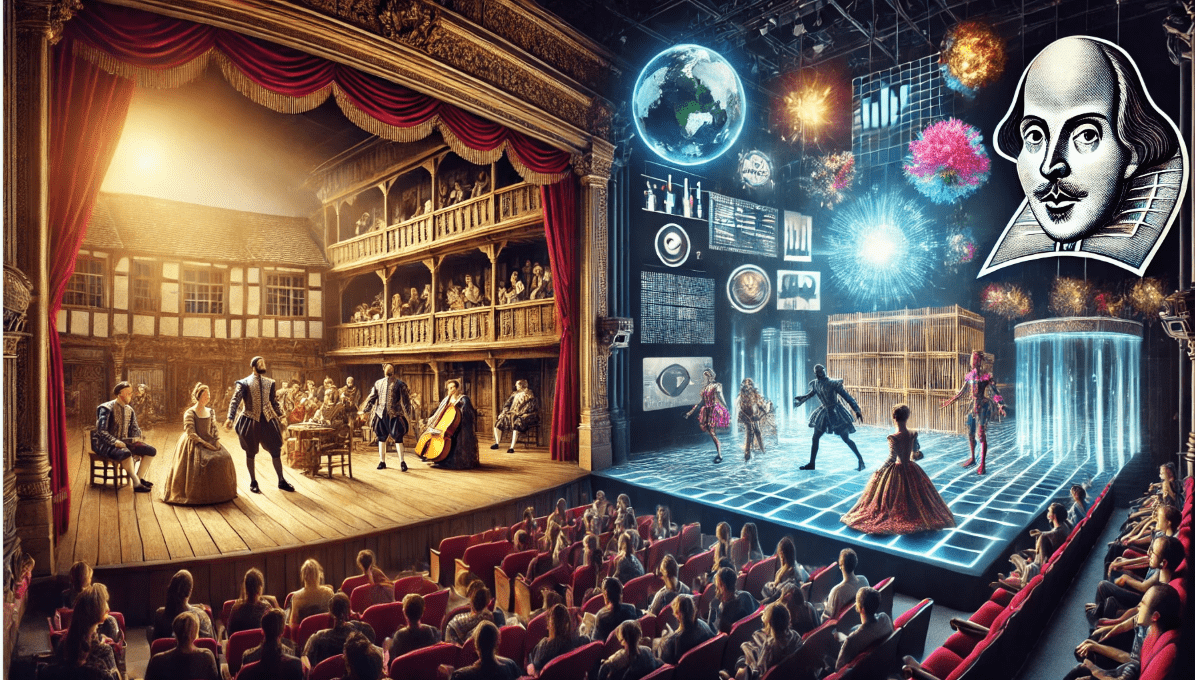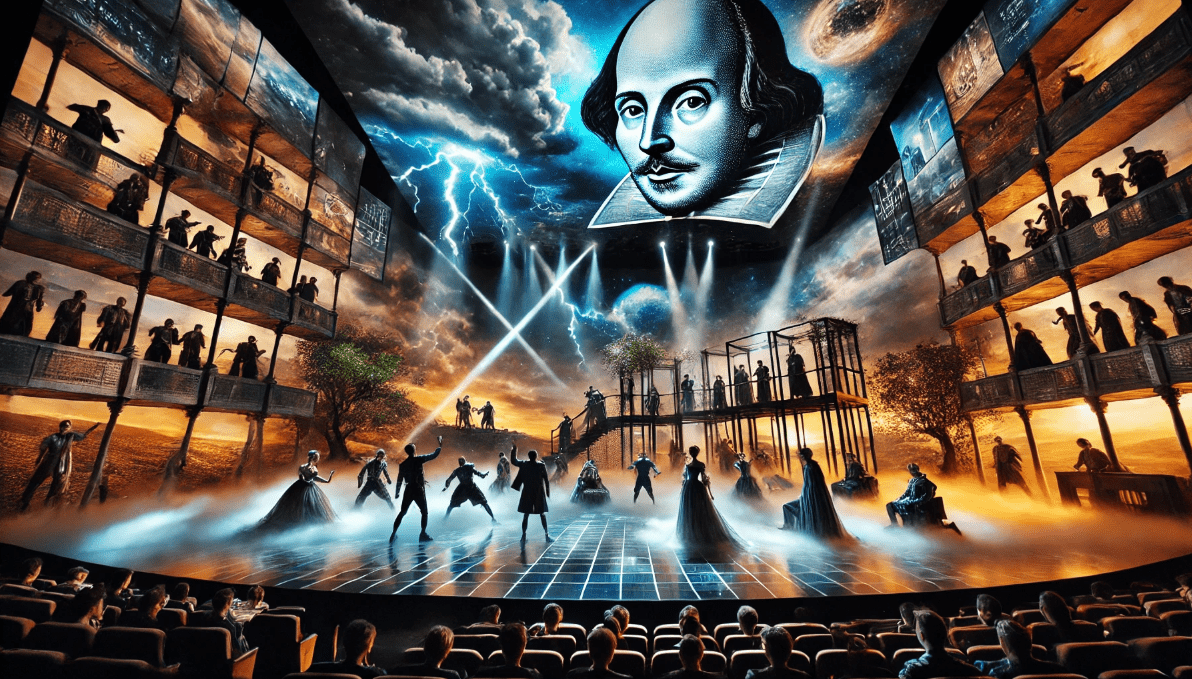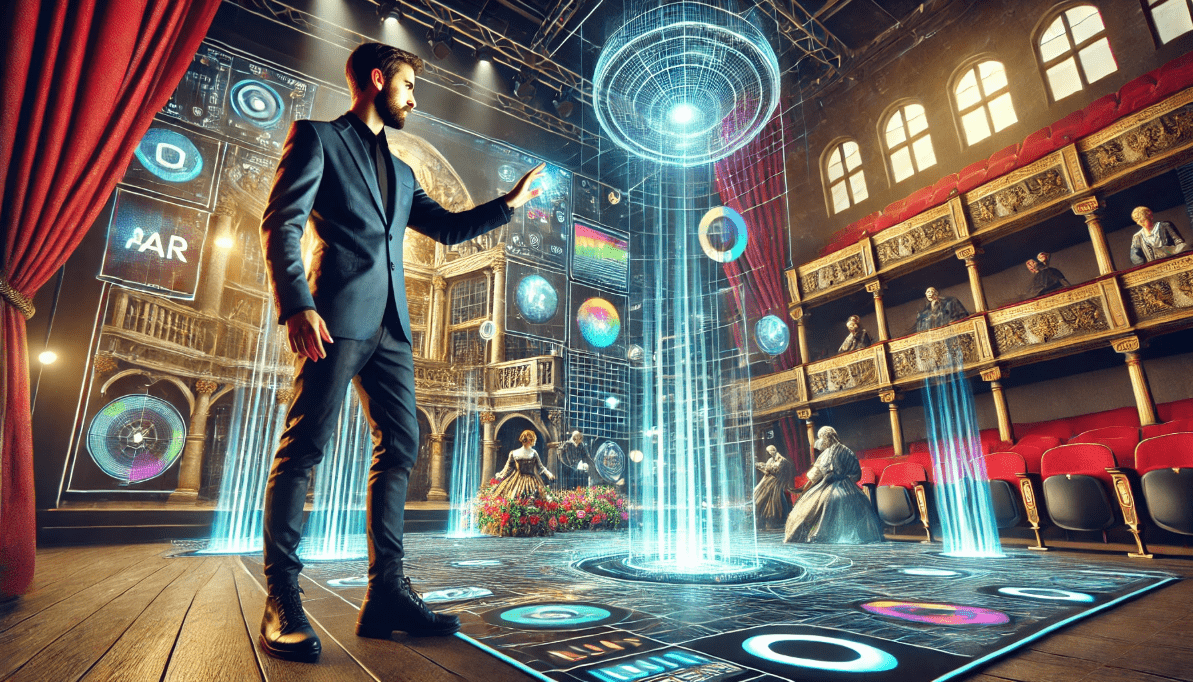Yes, Shakespeare’s plays are highly adaptable and can be reinterpreted to address modern issues such as politics, race, and social justice. For example, Julius Caesar can be set in today’s political environment to explore power dynamics, while The Merchant of Venice can reflect contemporary economic struggle.

Exploring Innovations in Shakespearean Performance: Modern Approaches to Reviving Classic Works
Shakespeare’s timeless works have graced the stage for centuries, captivating audiences with their complex characters and universal themes. Yet, in today’s fast-paced world, many people find these classic plays difficult to relate to. So, how do we keep Shakespeare relevant and exciting for modern audiences? The answer lies in innovations in Shakespearean performance. 🎭
In this article, we’ll explore how creative, modern approaches are transforming the way we experience these iconic plays. From immersive theater and cutting-edge technology to diverse casting and contemporary music, these innovations are reviving Shakespeare in ways that speak to today’s audience. Whether you’re a director, actor, educator, or simply a theater enthusiast, this guide will offer fresh insights into how we can continue to honor and evolve Shakespeare’s legacy. Ready to discover how the Bard’s works can feel brand new? Let’s dive in! 😊
Table of Contents
Toggle1: The Challenges of Reviving Classic Works
Reviving Shakespeare’s classic works in today’s world isn’t always a walk in the park. While his plays are filled with universal themes like love, power, and betrayal, many people—especially younger audiences—find it difficult to connect with the language and settings of centuries past. So, what are the main challenges faced by those who want to breathe new life into Shakespeare’s works? Let’s break it down. 💭
1.1: Engaging Modern Audiences

One of the biggest challenges is capturing the attention of modern audiences who are used to fast-paced entertainment and digital media. Shakespeare’s language, though beautiful, can feel dense and inaccessible to many, especially younger generations. The slow pace and older language often make it harder for people to see the relevance of his works in their own lives.
Practical Tip: To address this, many modern productions use subtitles or adapt Shakespeare’s language to make it more accessible. Some even incorporate pop culture references or contemporary themes, showing that Shakespeare’s works are still incredibly relevant today! 🌍
1.2: Balancing Tradition and Innovation
Shakespeare’s works are beloved partly because of their rich traditions—whether it’s the iconic Globe Theatre or specific directorial approaches. Yet, there’s a challenge in staying true to these traditions while also innovating and adapting the works to suit current times. Purists might resist the idea of deviating from the traditional way of presenting these plays, but doing so could risk alienating new audiences.
Practical Tip: A successful way forward is to find a balance between honoring Shakespeare’s legacy and introducing new elements like contemporary music, diverse casting, or modern set designs. This creates a bridge between the old and the new, making the experience richer for everyone involved. 🎤🎬
1.3: Overcoming the “Old-Fashioned” Perception
Despite Shakespeare’s influence on modern storytelling, many people still see his works as “old-fashioned” or “too complicated” to enjoy. This perception can make people hesitant to watch or engage with the plays, limiting their exposure to the beauty and complexity of Shakespeare’s writing.
Practical Tip: Theater companies can overcome this challenge by embracing experimental formats. Immersive theater, where the audience actively participates, or re-imagined settings, such as a Romeo and Juliet set in a modern-day high school, can draw in those who might otherwise skip the show.
2: Key Innovations Shaping Modern Shakespearean Performance

Shakespeare’s works may be centuries old, but modern innovations are helping them resonate with today’s audiences in fresh, exciting ways. Let’s take a look at the key innovations that are shaping the future of Shakespearean performance. These approaches not only breathe new life into the plays but also make them more engaging and accessible for modern viewers. 🎭
2.1: Technology and Visual Effects
One of the most significant changes in modern Shakespearean performances is the integration of technology. From stunning visual projections to immersive lighting designs, technology is enhancing the storytelling experience. Imagine Macbeth staged in a dark, eerie castle with projected storm clouds and shifting landscapes—technology brings the world of the play to life in ways never seen before.
Practical Tip: Directors can use technology to create mood, set the scene, and even immerse the audience in interactive environments. For example, virtual sets or projections can transport the play from a traditional stage to various locations, offering a more dynamic viewing experience. 🌟
2.2: Gender-Blind and Diverse Casting
Traditionally, Shakespeare’s characters were played by actors of specific genders, but today’s theater is embracing more inclusive casting practices. Gender-blind casting, where actors of any gender can take on roles traditionally played by another gender, is challenging norms and adding depth to the characters. Take, for example, a King Lear played by a female actor—this not only offers a fresh perspective but also emphasizes the universality of Shakespeare’s themes.
Practical Tip: Casting diverse actors from different ethnic and cultural backgrounds brings new interpretations to the characters. This enriches the performance and ensures that the themes of Shakespeare, such as power, love, and betrayal, resonate across different communities. 🌍
2.3: Contemporary Music and Sound Design
Music plays a huge role in modernizing Shakespeare’s works. Today, many performances incorporate contemporary music genres such as hip-hop, electronic, and indie rock to create an energetic, modern atmosphere. Imagine a Romeo and Juliet with a soundtrack featuring emotional ballads or intense rap battles—music has the power to amplify the emotional intensity and make Shakespeare’s timeless themes feel immediate and relevant.
Practical Tip: When using modern music, it’s important to ensure that the tone matches the emotional landscape of the play. A mix of classical and contemporary music can create a powerful fusion that speaks to both traditional theatergoers and younger, music-driven audiences. 🎶
2.4: Immersive and Interactive Theater
Interactive theater is revolutionizing the way audiences experience Shakespeare’s works. Gone are the days of passive spectatorship—today, audiences are invited to actively participate in the performance. In productions like Sleep No More (based on Macbeth), the audience is free to wander through different spaces, watching scenes unfold around them. This immersive experience allows viewers to engage directly with the characters and the story, creating a deeper emotional connection.
Practical Tip: Consider designing a performance where the audience is not just watching but engaging in the action. This can include everything from choosing what happens next to participating in key scenes. Immersive theater can turn a traditional performance into an unforgettable experience. 🌀
3: Reinterpreting Shakespeare’s Classic Characters
Shakespeare’s characters are some of the most iconic in literary history. But how can we make these familiar figures feel fresh and relevant in today’s world? Reinterpreting Shakespeare’s classic characters with modern perspectives is one of the most powerful ways to breathe new life into his plays. Let’s explore how these characters can be reimagined to captivate contemporary audiences. 🔄

3.1: Modern Spins on Iconic Characters
One of the most exciting ways to innovate Shakespearean performance is by reimagining his characters through a modern lens. Imagine Macbeth not as a Scottish king but as a ruthless corporate CEO, driven by ambition and power. Or picture Romeo and Juliet in a present-day conflict, where the two families represent opposing political or social groups. These reinterpretations allow the audience to see the timelessness of Shakespeare’s themes while relating them to modern issues.
Practical Tip: Think about the central traits of each character—ambition, love, jealousy—and how those traits exist in modern society. By placing these characters in contemporary settings, you can explore how their motivations and challenges are just as relevant today as they were in Shakespeare’s time. 🔍
3.2: Shifting Gender Roles
Another innovative approach is reinterpreting Shakespeare’s characters by changing their gender. Shakespeare’s works often feature strong male and female roles, but modern performances are beginning to flip these roles, offering fresh insights. For example, casting a woman as Hamlet or a man as Ophelia can completely alter the dynamic of the play, offering new perspectives on themes like power, vulnerability, and identity.
Practical Tip: When casting in gender-blind or gender-flipped roles, it’s important to explore how this change shifts the character’s power dynamics and relationships. Consider how a female Macbeth or male Lady Macbeth might change the emotional landscape of the play. 👩🎤👨🎤
3.3: Cultural and Societal Contexts
Shakespeare’s characters are also open to reinterpretation within different cultural contexts. Imagine The Merchant of Venice set in modern-day New York or Othello reimagined in a contemporary corporate setting. By changing the cultural background, directors can highlight new societal issues, such as class struggles, racial tensions, or political conflict, while still preserving the core of the play’s message.
Practical Tip: Don’t be afraid to think outside the box when placing Shakespeare’s characters in different times and places. Whether it’s shifting the setting to a dystopian future or a bustling metropolis, the underlying human emotions and conflicts in Shakespeare’s plays remain universal. 🌎
3.4: Deepening Psychological Complexity
Shakespeare’s characters are known for their complexity, but modern interpretations can dive even deeper into their psychological profiles. For example, exploring Hamlet’s indecision not just as a moral dilemma but as a psychological struggle, or rethinking Lady Macbeth‘s guilt as a product of post-traumatic stress, can add layers of complexity to the performance. These interpretations make the characters feel more human, more relatable, and more relevant to today’s psychological understanding.
Practical Tip: Modern psychological insights can deepen the portrayal of Shakespeare’s characters. Consider integrating concepts from modern psychology, such as trauma, mental health, or identity crises, to bring a fresh and relatable perspective to these age-old figures. 🧠
4: Notable Modern Shakespearean Adaptations

Over the years, many Shakespearean plays have been adapted in exciting and innovative ways. These adaptations show how flexible and timeless Shakespeare’s works truly are. By reimagining the setting, updating the language, or even flipping the characters, these modern adaptations make his plays feel fresh, engaging, and relevant to today’s world. Let’s explore some of the most notable adaptations that are reshaping how we experience Shakespeare. 🎭
4.1: 10 Things I Hate About You – A Modern Taming of the Shrew
One of the most famous modern adaptations is 10 Things I Hate About You, a 1999 teen romantic comedy based on Shakespeare’s The Taming of the Shrew. Set in a high school, the film updates the characters and plot while maintaining the core themes of love, rivalry, and transformation. By placing the story in a contemporary setting, it resonates with younger audiences who may not otherwise connect with the original play.
Practical Tip: When adapting Shakespeare for modern audiences, consider how his themes—like relationships and personal growth—can be explored in a contemporary context. Changing the setting to a high school or workplace can make the story more relatable without losing the play’s essence. 💕🏫
4.2: The Lion King – A Hamlet Reimagining
Disney’s The Lion King (1994) is one of the most famous modern adaptations of Hamlet. The film’s plot mirrors that of Shakespeare’s tragedy, with a young lion named Simba avenging the death of his father, King Mufasa, at the hands of his uncle Scar. While the setting is an African savanna and the characters are animals, the emotional depth and universal themes of power, betrayal, and family loyalty remain intact.
Practical Tip: You don’t need to keep the original setting to stay true to Shakespeare’s core themes. By adapting the basic narrative and themes, you can create something entirely new while preserving the emotional power of the original play. 🦁👑
4.3: The Public Theater’s Shakespeare in the Park – Modernizing Shakespeare for a Diverse Audience
The Public Theater’s Shakespeare in the Park productions in New York are known for modernizing the Bard’s works to reflect current social and political issues. For example, their 2017 production of Julius Caesar set in a modern political climate stirred up national conversation by drawing parallels between the assassination of Caesar and contemporary political events.
Practical Tip: Consider incorporating current events and social issues into your adaptation. By connecting Shakespeare’s plays to the issues of today, you make the material feel more immediate and relevant to your audience. 🌍🎤
4.4: Ruined – A Contemporary Take on The Merchant of Venice
Ruined, a play by Lynn Nottage, is a powerful contemporary adaptation of The Merchant of Venice. Set in the war-torn Congo, it deals with themes of survival, justice, and economic struggle, paralleling the themes of Shylock’s desire for justice in Shakespeare’s original play. The modern setting adds depth to the issues of revenge, mercy, and the complexity of human emotion.
Practical Tip: Setting Shakespeare’s plays in modern or global contexts allows you to address universal issues such as human rights, justice, and social inequality, all while staying true to the themes of the original play. 🌏⚖️
4.5: She’s the Man – A Twelfth Night Reboot
Another popular modern adaptation is She’s the Man (2006), which reimagines Twelfth Night as a teen comedy. In this version, a girl disguises herself as her twin brother to play on the boys’ soccer team, leading to romantic confusion and humorous situations. While the setting is high school, the themes of mistaken identity and love triangles are faithful to the original play.
Practical Tip: Comedy and romance are timeless elements in Shakespeare’s plays. By updating the setting and using humor that resonates with modern sensibilities, you can make his works more accessible to younger generations. 😂⚽
5: How to Apply Innovations in Your Own Shakespearean Performances

Ready to bring some innovative flair to your Shakespearean performances? Whether you’re a director, actor, or educator, applying modern techniques can transform a classic play into something exciting and fresh. Here are some practical, actionable tips to help you infuse your productions with innovation while staying true to the essence of Shakespeare’s work. 🎭✨
5.1: Embrace Technology for Visual Impact
One of the most powerful tools you have is technology. From lighting and projections to augmented reality (AR) and virtual sets, technology can completely transform a traditional stage into a dynamic, immersive experience.
Practical Tip: Use projections to create shifting landscapes or time periods in your production. For example, in Macbeth, project images of a dark, stormy castle to set the eerie mood, or in A Midsummer Night’s Dream, use AR to make the forest come alive with magical creatures. 🌟
5.2: Think Outside the Box with Casting
Today’s theater embraces diversity and inclusivity like never before. Gender-blind casting and choosing actors from various backgrounds can bring new dimensions to Shakespeare’s characters, making them more relatable and impactful. Think about the power dynamics and themes in the play and how casting choices can reflect or challenge them.
Practical Tip: Experiment with non-traditional casting. Imagine Hamlet played by a woman or a multicultural Romeo and Juliet. It opens up new interpretations and invites the audience to reconsider the traditional roles and relationships. 🌍👩🎤
5.3: Modernize the Soundtrack
The music in your production plays a huge role in setting the tone. By blending classical scores with modern genres, you can create an atmosphere that resonates with today’s audience. Contemporary music such as hip-hop, electronic beats, or indie rock can bring energy and emotion into the performance, making the Shakespearean experience feel more current.
Practical Tip: Pair contemporary music with Shakespeare’s timeless themes. For instance, use a dramatic electronic soundtrack in a scene of betrayal from Julius Caesar or hip-hop in a confrontation scene from Othello to bring out the intense emotions. 🎶💥
5.4: Experiment with Set Design and Costumes
The set and costumes are essential for creating the world of the play. Consider minimalist or avant-garde designs that highlight key elements of the story. You don’t need a lavish, traditional set to make an impact—sometimes less is more. You can also use costumes that reflect contemporary fashion or even stylized versions of historical attire to create a unique visual experience.
Practical Tip: Instead of a traditional throne room for King Lear, try a modern corporate office or a post-apocalyptic setting. This shift will give the play a fresh context while preserving the original themes of power and family. 🏰👗
5.5: Make Your Performance Interactive
Modern audiences crave interaction, and immersive theater is a great way to engage them. By inviting the audience into the world of the play—whether by encouraging them to make choices or by having them physically move through different spaces—you can make Shakespearean performances feel more engaging and participatory.
Practical Tip: In Romeo and Juliet, you could invite the audience to “witness” key moments, like the famous balcony scene, from different angles. You could even involve them in choosing how characters react to pivotal events, making the experience feel personal and dynamic. 🔄🎉
5.6: Use Modern Themes and Contexts
While Shakespeare’s plays cover universal themes like love, betrayal, and ambition, you can update the context to reflect current events or societal issues. For example, The Merchant of Venice could address modern issues of financial inequality or corporate greed, while Macbeth could explore the political corruption in today’s world.
Practical Tip: Choose one or two major themes from the play and reframe them within a contemporary context. This could involve setting Julius Caesar in a modern-day government or depicting Othello as a workplace drama where race and power dynamics play out in an office environment. 🏛️📱
6: Common Challenges and Solutions
While innovations in Shakespearean performance can bring exciting new elements to the stage, there are also challenges to consider. Let’s explore some of the most common hurdles and practical solutions to overcome them, ensuring your Shakespearean production remains fresh, relevant, and effective. 🎭
6.1: Balancing Tradition with Innovation
One of the biggest challenges is striking the right balance between respecting the tradition of Shakespeare’s work and introducing innovative elements. Theatergoers who love the traditional performances may resist any major changes, fearing that they’ll lose the essence of the original play.
Solution: Start with small, thoughtful changes that enhance rather than replace the original material. For example, introduce modern costumes or set designs, but maintain Shakespeare’s language and themes. By preserving the core of the play while updating the visual and contextual aspects, you can keep both purists and new audiences engaged. 🎨💬
6.2: Making Shakespeare’s Language Accessible
Shakespeare’s language is often perceived as archaic and difficult to understand, which can turn off modern audiences, especially younger generations. If the audience struggles with comprehension, they may miss the emotional depth and beauty of the play.
Solution: Consider offering subtitles or modern translations alongside the performance. You can also use spoken word or dynamic delivery techniques to bring out the natural rhythm and flow of Shakespeare’s language, making it more accessible. Alternatively, consider adapting the text to incorporate some modern language without losing the core of the original. 📜🎤
6.3: Ensuring Relevance for Today’s Audience
Shakespeare’s works are filled with timeless themes, but the context can sometimes feel distant from modern-day issues. Audiences might struggle to connect the themes of power, betrayal, and love to their own lives if the production doesn’t feel relevant to their experiences.
Solution: Bring contemporary issues into the performance. You could set Macbeth in a corporate setting to explore themes of ambition and power or reinterpret Romeo and Juliet to reflect current societal divides. By connecting Shakespeare’s timeless themes to modern social, political, or personal issues, you help the audience see the play’s relevance today. 🌎💡
6.4: Managing Audience Expectations
When producing a Shakespearean play, expectations can vary. Some audiences expect a traditional, classical experience, while others may seek a modern, innovative approach. Striking the right balance can be tricky, especially when your audience is divided in their preferences.
Solution: Consider diversifying your approach to reach both traditional and modern theatergoers. One way to do this is by offering previews or promotional materials that showcase your innovative approach, so your audience knows what to expect. Additionally, offering a mix of performances (e.g., one traditional and one experimental) can allow you to cater to both preferences. 🎟️🎭
6.5: Overcoming Resistance to Change
Innovation often meets with resistance, particularly in established theater circles. Critics, actors, or even audience members may be hesitant about deviating from Shakespeare’s original works or fearful that new approaches will undermine the integrity of the plays.
Solution: Communicate clearly about the reasons for your innovative choices. Explain how these changes enhance the understanding and enjoyment of Shakespeare’s work, rather than replacing it. Offering educational programs or behind-the-scenes discussions can also help build understanding and support for your approach. 📚🎤
Embracing Innovation for the Future of Shakespearean Performance
Shakespeare’s works have stood the test of time because they tap into universal themes—love, betrayal, power, and ambition—that continue to resonate with audiences across generations. However, to keep these timeless stories alive and relevant, embracing innovation is essential. By applying modern approaches like technology, diverse casting, immersive experiences, and contemporary music, we can transform Shakespeare’s plays into something fresh, engaging, and relatable for today’s world. 🎭
Innovations in Shakespearean performance don’t mean abandoning the core of his works. Instead, they allow us to explore these stories in new and exciting ways while staying true to the heart of what makes Shakespeare’s writing so powerful. Whether you’re a director, actor, educator, or theater enthusiast, there’s always room to experiment, push boundaries, and create performances that connect with audiences in meaningful ways. 💡
As you move forward with your own Shakespearean endeavors, remember that the key is to honor the essence of the plays while finding creative ways to make them speak to today’s world. The possibilities for innovation are endless—so take the leap and watch as Shakespeare’s timeless tales continue to evolve and inspire new generations of theatergoers. 🌟
Frequently Asked Questions (FAQs)
1. What are the main innovations in Shakespearean performance?
Innovations in Shakespearean performance include the use of technology (like projections and virtual sets), diverse casting, contemporary music, and immersive theater techniques. These innovations bring Shakespeare’s timeless themes into modern contexts, making his plays more engaging and relevant to today’s audiences.
2. How does modern technology enhance Shakespearean performances?
Modern technology enhances Shakespearean performances by creating dynamic, immersive environments with digital projections, lighting effects, and sound design. These elements help bring the play’s world to life, offering audiences a more engaging experience beyond traditional stage settings.
3. What is gender-blind casting in Shakespearean theater?
Gender-blind casting involves casting actors in roles regardless of their gender. In Shakespearean theater, this means that characters traditionally played by men or women can be performed by any actor, opening up fresh interpretations and adding depth to the characters.
4. How can contemporary music be used in Shakespearean performances?
Contemporary music, such as hip-hop, indie, or electronic, can be integrated into Shakespeare’s plays to modernize the tone and atmosphere. This creates a connection with younger audiences and brings out the emotional intensity of the play, making it more relatable.
5. What challenges come with modernizing Shakespeare’s works?
The main challenges include balancing the traditional integrity of Shakespeare’s text with modern interpretations, ensuring accessibility of his language, and overcoming resistance to change from traditionalists. However, thoughtful updates, such as using contemporary settings or modern themes, can help bridge the gap.
6. Why is immersive theater important for Shakespearean performances?
Immersive theater allows the audience to interact with the performance, often moving through different spaces or engaging with the actors. This innovative approach makes Shakespeare’s works more dynamic and personal, drawing viewers deeper into the world of the play.
7. How do modern adaptations of Shakespeare's plays stay true to the original text?
Modern adaptations often stay true to the original text by preserving Shakespeare’s core themes and dialogue while updating the setting, music, and visuals. The goal is to reflect contemporary issues and make the themes more relevant without losing the essence of the play.
